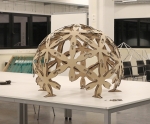The research aims to develop a deployable and reusable structural system that fosters the circularity of both structural elements and materials. This objective is pursued through the combination of the inherent deployability mechanisms found in scissor structures with the structural robustness of surface-active structures. The resultant hybrid system is envisioned to outperform widely used textile structures in terms of structural integrity, security, and durability while retaining the adaptability and construction ease associated with deployable scissor grids.
The possible solution should be versatile and could be optimized for a diverse array of applications, ranging from temporary shelters such as post-crisis relief structures, hospital pods, and markets, to more temporary constructions such as deployable scaffoldings tailored for shell structures. The research involves designing and prototyping structures specifically tailored for specific case studies across these diverse applications. In addition, additive manufacturing technology will be employed to create innovative joint hubs, crucial for seamless integration between deployable systems and surface-active structures. These novel joints are expected to enhance the functionality of scissor systems, unlocking a versatile library of geometric forms.

